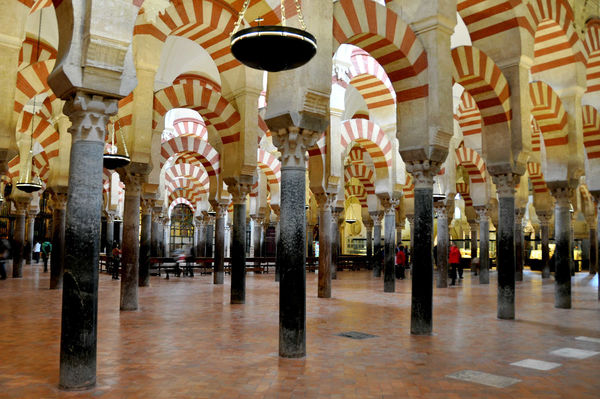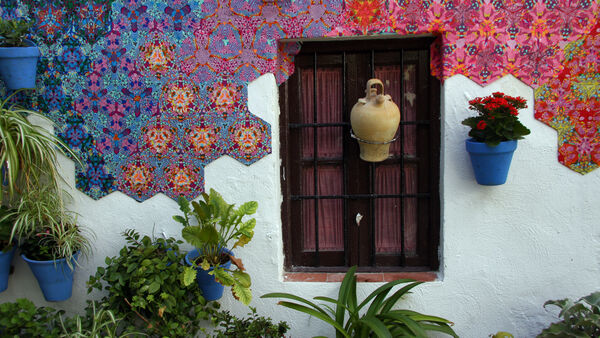The Allure of Córdoba
By Rick Steves

Tucked into a bend of its river, the Andalusian town of Córdoba has a glorious Moorish past. While its old wall evokes the history of a long-ago empire, its elegant cityscape and convivial squares show a modern pride. Typical of southern Spain, it's a people-friendly place filled with energy and color.
Córdoba's centerpiece is its massive former mosque — or, in Spanish, mezquita. Magical in its grandeur, this huge building dominates the higgledy-piggledy old town that surrounds it. A wonder of the medieval world, the former mosque is remarkably well-preserved, giving visitors a chance to appreciate Islamic Córdoba and the glory days of Muslim rule.
Imposing gates lead to an outdoor courtyard sheltered by orange trees. Long ago, worshippers washed here before prayer, as directed by Muslim law. Entering the mosque, you step into a fantastic forest of delicate columns and graceful arches that seems to recede into infinity, as if reflecting the immensity and complexity of God's creation.
In this majestic space, it's easy to picture Córdoba as the center of a thriving and sophisticated culture. At its zenith in the 10th century, it was the leading city of Western Islam and a cultural hub that rivaled Baghdad and Constantinople. In an era when much of Europe was barbaric and illiterate, Córdoba was a haven of enlightened thought — famous for a remarkable spirit of religious tolerance, artistic expression, and dedication to philosophy and the sciences. Jews, Christians, and Muslims had figured out how to live together more or less harmoniously. Everyone spoke the same language, cooked the same dishes, wore the same type of clothes, and shared the same public baths. It was one culture, with three religious traditions.
But in 1236, when Christians conquered the city, everything changed. According to legend, one morning Muslims said their last prayers in the great mosque, and that afternoon the Christians set up a portable altar to celebrate their first Mass. Later, as if planting a cross into the mosque's religious heart, they built a massive cathedral in the middle of the Mezquita. Towering overhead, the cathedral's bell tower encloses what had been a minaret. In its juxtaposition of traditions, the Mezquita uniquely embodies the interplay of Spain's Christian and Muslim cultures.
Córdoba also boats a fortress (the Alcázar), 14th-century synagogue, Roman bridge, and the Museum of Al-Andalus Life (offering a look at Moorish Córdoba) — but most tourists leave the city having seen only the Mezquita and the trinket shops and cute medieval quarter that surround it.
Even if you only have time for a short visit, it's easy to explore beyond the crowds and tacky shops. A short walk beyond the tourist zone takes you to a zigzag of residential lanes, whitewashed and narrow. People really live here, and just about the only tourist is…you.
On every visit, I set out on a scavenger hunt for the city's best patios. These semi-hidden spaces, usually tucked behind ornate ironwork gates, are where residents go to escape the heat. Many are full of lovingly tended potted gardens — so lovingly that every May owners compete in an intense contest to have theirs named the city's most attractive patio.
Mid-spring is prime time to visit Córdoba, especially for flower fans. First comes the Battle of the Flowers parade, held on a Sunday in late April or early May, with women in traditional dress tossing flowers from blossom-covered floats to eager crowds.
Next, for the Festival of the May Crosses, neighborhoods proudly make and display ten-foot crosses festooned with flowers. Residents gather for months beforehand to prepare their crosses in secret; in an earlier era, the work parties were an excuse for young singles to meet. In the last week of May is the city's Spring Fair, full of colorful costumes, wine, tapas, and flamenco flair — much like Sevilla's more famous April Fair (but here, every party tent is open to everyone).
Córdoba is an easy day trip by train from Sevilla — but if you really want to know the place, spend the night. Like everywhere in southern Spain, evening is prime time. Throughout the spring festival season, locals pack the squares in community-wide celebrations. During the Festival of the Crosses, each neighborhood association sets up a bar next to its flowered cross to serve drinks and tapas (the local specialty is salmorejo, a creamy version of gazpacho). Mellow guitar notes and seductive flamenco beats fill the air.
Experiencing the traditional culture of Córdoba — celebrated by and for its locals — trumps any packaged tourist show. With its beautiful courtyards, lively traditions, and infectious atmosphere, Córdoba rewards those who aren't in a hurry.

